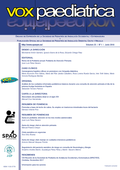![]()
Diagnóstico por imagen de malformaciones urológicas en la edad pediátrica
Las malformaciones congénitas del riñón y del tracto urinario o CAKUT son una de las anomalías más frecuentemente identificadas en ecografía prenatal y la causa principal de enfermedad renal terminal en la infancia.
Las dilataciones de la vía urinaria suponen el grupo más numeroso de anomalías detectadas por ecografía prenatal y representan un amplio espectro de condiciones clínicas que varían desde fenómenos fisiológicos y transitorios a malformaciones que traducen trastornos graves.
La ecografía prenatal, particularmente a partir del segundo trimestre de gestación, es una herramienta muy útil e inocua para el diagnóstico de las malformaciones renales y la valoración pronóstica de la funcionalidad renal. La valoración postnatal y seguimiento también se realiza fundamentalmente por Ecografía. Otros métodos de imagen como Cistouretrografía miccional y la Gammagrafía aportan información adicional muy valiosa en relación a la presencia de reflujo y cicatrices renales u obstrucción renal, respectivamente.
Congenital malformations of the kidney and urinary tract or CAKUT are one of the most frequently identified abnormalities in prenatal ultrasound and the leading cause of end-stage renal disease in childhood.
The expansions of the urinary tract are the most numerous anomalies detected by prenatal ultrasound group and represent a wide spectrum of clinical conditions ranging from physiological and transitory phenomena to malformations that result in severe disorders.
Prenatal ultrasound, particularly from the second trimester of pregnancy, is a very useful and safe tool for the diagnosis of renal malformations and prognostic assessment of renal function. Postnatal assessment and monitoring are also mainly done by ultrasound. Other imaging methods such as the urethrocystography and the scintigraphy provide valuable additional information regarding the presence of reflux and the renal scarring or renal obstruction, respectively.
| Adjunto | Tamaño |
|---|---|
| vox_paediatrica_2-2016_web.28-39.pdf | 992.38 KB |



